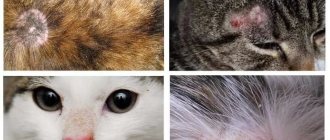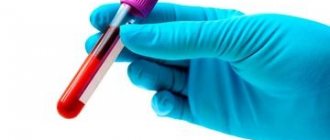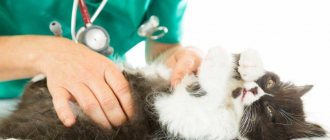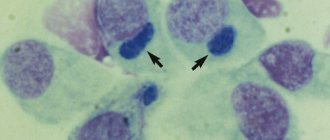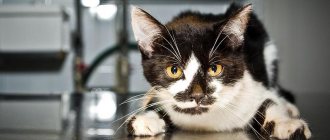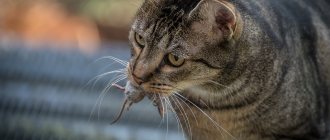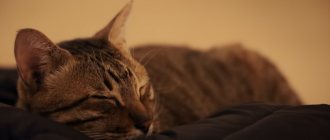What is trichophytosis
Trichophytosis is a skin fungal disease that is infectious in nature. A very persistent fungus that quickly covers the entire surface of the skin of an infected animal.
Individuals with weakened immune systems are primarily susceptible. At the site of infection, a rash, redness, and hair fall out on the skin. The animal experiences unbearable itching and scratches these places. In place of watery blisters, scabs form, under which a purulent process occurs.
When neglected, the lesions grow, connect and cover almost the entire body with scales and sores. The victim's claws are modified and separated. Without assistance, the disease ends in death. Cases of self-healing are rare and are observed only in street animals with strong immunity.
Ways of transmission of the disease
The main routes of transmission of trichophytosis are contact and nutritional methods. A short contact between a healthy cat and a sick or recovered animal is sufficient. All types of warm-blooded animals are reservoirs of fungal infection.
Fungal spores can be everywhere - on grass, in soil, grass, plants, water, feed, bedding, toys, hygiene and animal care products (combs, brushes).
Trichophyton can get into the house on the owner’s clothes, shoes, or any objects with which an animal with shingles has had contact. Even if your cat does not walk outside, do not exclude the possibility of your pet becoming infected with lichen.
How cats can get infected
Even completely indoor keeping does not eliminate the risk of trichophytosis in cats. Spores can be brought in on the soles of shoes or from the street. In a private home, there is a high probability of infection from mice or rats.
If you let your cat outside for a walk, contact with yard animals is inevitable, which can lead to illness. A well-fed and healthy pet can be a carrier of spores of this fungus for a long time. In the future, any weakening of his immunity, for example, poor nutrition or taking antibiotics, inhibits the bacterial flora and leads to the development of trichophytosis fungus.
What is ringworm?
Ringworm is a well-known name for a group of skin diseases caused by two types of pathogenic fungi: Microsporum and Trichophyton. Depending on the pathogen, medicine distinguishes between the types of this disease. Microsporia is a type of lichen caused by fungi of the genus Microsporum. Accordingly, trichophytosis is of the genus Trichophyton. But since both diseases are similar in symptoms and course, among pet owners (and not only) there is a common name for the disease - ringworm .
Symptoms
The initial stage of development of the fungus is manifested by a focal rash on the skin. A rash appears in the form of watery blisters with redness of the surrounding area. The wool breaks off and falls off. Visually it looks as if it was cut with scissors. The claws become exfoliated and thicken.
Ringworm usually begins to develop on the head and neck, then the back and paws are affected. The cat hides in a secluded place, eats poorly, and looks weak.
Having noticed such signs, it is necessary to urgently undergo diagnostics at the clinic in order to begin treatment for your beloved pet on time.
Disease prevention
To prevent your cat from contracting dermatological infections, disease prevention involves following basic rules.
Preventive techniques include:
- timely immunization;
- compliance with hygiene and zootechnical standards;
- creation of optimal conditions of detention;
- systematic care;
- keeping the house or apartment clean, frequent cleaning;
- organization of the nutrition system, a complete diet.
Protect your cat from adverse factors that weaken the body. Supplement your natural diet with complex vitamin complexes to activate your defenses. Pay attention to your pet's hygiene. Treat fur against ectoparasites.
If your cat is walking outside, inspect the body for damage after the walk. If there are wounds or scratches, treat them with an antiseptic.
Diagnostic methods
The external signs of trichophytosis are similar to a number of other fungal diseases that have different treatment methods, so it is important to undergo diagnostics at a veterinary hospital; take a stool test to determine worm infestation; check the level of leukocytes in the blood.
Diagnosis is carried out by three methods:
- Luminescent - irradiation of the affected area with a Wood's lamp. The presence of this disease is indicated by a green glow in the fur. The diagnosis is only 50% reliable.
- Microscopic - examine the scab particle under a microscope. Confirmation of infection is the presence of whitish threads of myxomycetes.
- Mycological is the most reliable and long-lasting method. A scraping is taken from the skin of the diseased individual and placed in a nutrient medium. The growth of the fungal colony is monitored for three months in order to determine its variety.
Contacting specialists is necessary because the disease is transmitted to people and is infectious in nature.
How is ringworm diagnosed in cats?
Diagnosing ringworm is not difficult. The owner of the animal can suspect the presence of the disease when he discovers round spots devoid of fur on his pet. A veterinarian can make an accurate diagnosis using the following studies:
- Scraping the affected area of skin. It is considered the most reliable method, but it is a rather lengthy procedure that takes about 10 days.
- Luminescent method using a Wood's lamp. Under the influence of ultraviolet rays of the lamp, hair affected by the fungus begins to glow with an emerald green light. But this test detects only some strains of Microsporum Canis, so a negative result does not rule out a fungal infection. For example, hair affected by a fungus of the genus Trichophyton does not glow.
- Microscopic examination of the affected fur. The procedure is quick and detects approximately half of the cases.
Treatment options
Treatment of a mild form of trichophytosis in a cat involves applying an ointment, spray or solution to the areas of infection and treating the floor and furniture with chlorine. The procedures are carried out using rubber gloves.
When treating an infected area, you must keep in mind that colonies of the fungus are able to catapult to the side from the treated surface. Therefore, the hair around the fireplace is trimmed. The medicinal product begins to be distributed from the trimmed, healthy edge, gradually closing the circle in a spiral to the epicenter.
Before applying the ointment, treat the area with a solution and apply the ointment twice a day. Treatment is carried out for two months. Applicable:
- ointments Yam, Mykozon, Sanoderm;
- sing Fungin;
- Nizoral shampoo in combination with a cream of the same name;
- solutions Imaverol, Fukortsin.
As prescribed by the doctor, they are treated with antibiotics: Yarunin, Fluconazole, Ketoconazole, Griseofulvin, Itraconazole.
An effective and practice-tested folk remedy for removing lichen:
- The preparatory stage is the same as described above.
- The fire is treated with iodine and ash mixed with vegetable oil or birch tar is applied.
To prevent the cat from licking its fur, wear a protective collar.
Treatment regimen for trichophytosis in cats, treatment methods
The treatment regimen for trichophytosis is prescribed individually and depends on the severity, degree of damage, form of fungal infection, virulence of the fungus, and age of the cat. Animals are prescribed medications for general therapy and local use.
Important! To avoid harming your cat, do not self-medicate. All medications, their dosage, and treatment regimen will be selected by the veterinarian. Special control is carried out when treating pregnant, lactating females, and weakened cats.
In the treatment of trichophytosis the following is used:
- agents that have an antifungal effect in tablets, ointments, liniments, solutions, injections;
- symptomatic medications (anti-inflammatory, wound healing, analgesics);
- homeopathy remedies;
- immunostimulants to enhance defenses, vitamin complexes (Gamavit, Vetom1.1, Neoferon, Imunofan);
- physiotherapeutic techniques.
Important! Treatment of trichophytosis is complex. On average, the course ranges from three to four weeks to 2-3 months. It all depends on the severity of the infection and the condition of the cat.
Along with medications, antiparasitic and antifungal shampoos, balms, sprays (Nizoral), antiparasitic drops, as well as alternative medicine are used. The lesions are treated with decoctions and tinctures of medicinal herbs.
During treatment, isolate the cat with deprivation from other pets and children.
To prevent your cat from licking off the applied medications, put a protective collar (Elizabethan collar) on your pet. You can make it yourself from cardboard, plastic, or buy it at a veterinary pharmacy, pet store, or veterinary clinic.
Prevention and vaccination measures
When purchasing a furry pet, all measures are taken to ensure the health and safety of the pet. At the age of six months, the Vakderm vaccine is administered.
Vaccination is carried out in two doses, with an interval of three weeks.
To prevent this terrible disease, a number of rules are followed:
- good nutrition;
- contacts with yard animals are excluded;
- regular use of anthelmintic and anti-flea drugs;
- keeping the tray clean and periodically cleaning with chlorine.
An attentive and sensitive attitude towards your pet will allow you to notice changes in behavior and provide timely help in case of illness.
Where and how can you get ringworm?
Ringworm is a contagious skin disease that can be transmitted to humans. Infection occurs in the following ways:
- Through direct contact with an infected animal or asymptomatic carriers (mainly long-haired cats).
- Through contact with contaminated environments and care items (including combs, brushes, mats, transport baskets, etc.).
Note! Not every contact with an infected animal inevitably leads to the development of the disease. People with strong immunity have many specific and non-specific defense mechanisms of the body that prevent infection. Young children are most susceptible to the disease.
Among animals, there are also certain factors that contribute to the infection and development of fungal infections:
- Repeated contact with infected relatives. For example, if several animals live in the house.
- Age. Kittens under one year of age and cats over 10 years of age are less resistant to infection.
- Anything that weakens the immune system: other diseases, parasites, poor feeding, poor ventilation, little sun and fresh air, stress, etc.
Signs and symptoms of the disease:
Based on these signs, it becomes clear that the cat is infected with lichen, but final conclusions will be made only after taking tests from the affected skin or fur of the animal.
- itching
- round hairless spots on a cat's skin. Sometimes pustules, blisters with liquid, and scales in the center appear
- increase in size of the spot
- Commonly affected areas: ears, head, tail
- hair loss
- fat content of the coat
- heavy shedding.
- formation of tangles.
- Damaged nails grow uneven and become deformed.
The symptoms of dermatitis and ringworm are, in some cases, similar. The cat owner should remember that the first signs of the disease are: excessive shedding and the frequent appearance of hairballs. The animal also scratches its ears often. When lichen is localized in the claws, they become deformed and grow incorrectly.
Types of ringworm
Currently, about forty different species of dermatophyte fungi are known that can infect different animals. In cats, most cases of dermatophytosis are caused by a fungus called Microsporum canis. This is a microorganism that can infect other species of animals, including dogs, as well as humans.
Microsporia. Caused by fungi Microsporum gypseum, Microsporum canis.
Trichophytosis. The causative agent is the fungus Trichophyton.
Despite the different names of microorganisms, the characteristics of both species are the same.
Because of the symptoms, this disease is called ringworm.
Where can a cat get infected? Causes
First of all, lichen is transmitted through contact with sick cats. Spores remain for a long time on objects that the animal has come into contact with, which means that it can become infected through a sleeping place, brushes, toys and other things.
At risk, cats that walk outside exchange bacteria with homeless, unvaccinated animals. For some time, the disease may not manifest itself in any way, and only after a few months the first signs and symptoms may appear.
Kittens under the age of one year, those who are poorly nourished, those who have previously suffered other diseases, and those infected with parasites are more susceptible to the disease.
Their immune system is unable to resist dermatophytes. Most cats do not get ringworm due to their good immune system.
The risk of contracting an infection increases if the cat is infected with parasites or if its diet is inadequate.
Microsporia (Microsporum gypseum, Microsporum canis.)
Ringworm. Trichophytosis (Trichophyton)
Main symptoms
The disease may not appear immediately after infection, but the fungus will definitely make itself known sooner or later.
The main signs of trichophytosis or microsporia in cats:
- The appearance of whitish skin flakes or dandruff in certain areas of the head or body.
- Hairless patches on the head, face, legs or back.
- Itching in the affected area.
- The claws peel off and turn brown.
- Ruffled fur.
- The appearance of suppuration on wounds where hair has fallen out (with prolonged absence of treatment).
- Sad looking pet.
This is interesting! 20% of cats do not show any symptoms of the disease, but they are still carriers of the infection. The disease will certainly manifest itself when the immune system is suppressed or as a result of stress.
Domestic cats become infected from stray cats or after hunting rats and mice. Source: Flickr (Jonathan_Kean)
Prevention
Following these rules will help you avoid getting infected and will save your cat:
- Vaccination of an animal against lichen.
- Never pet other people's cats. Teach your children to do this. Stray street cats are especially dangerous.
- Wash your hands with soap: every time you pet your pet; when you come home from the street; after contact with cat accessories: tray, toys, bed.
- Keep your cat away from dirty outdoor shoes and clothing. Wash your shoes when you get home. Clean your hallway regularly.
- Walk your cat in areas where there are no other animals. Avoid contact with stray animals. It is best to keep your pet in an apartment.
- Isolate a cat infected with shingles from other pets and children for the entire course of treatment.
- At the first indirect signs: restlessness, frequent scratching, take the animal to the veterinarian to make or rule out a diagnosis of ringworm.
Important!
Remember that timely detection of pathology and proper treatment will definitely return your pet to health and will not harm the health of your family!
Vaccination against ringworm
Therapeutic and prophylactic vaccinations against lichen in cats are carried out as part of complex therapy for an animal or for healthy animals as a preventive measure. Vaccinations are given to healthy kittens at the age of 3 months.
Therapeutic vaccination is the most effective modern way to get rid of fungal infections of the skin and fur of cats. Injections are given 2-3 times with an interval of 10-14 days.
Vaccines used in veterinary medicine:
- Polivac TM is a highly effective vaccine based on 8 types of strains of weakened fungi (trichophytin, microsporum). The effect of the vaccine lasts 12-14 months. To develop lasting immunity, a second vaccination is carried out 14 days after the first. Vaccination of healthy cats does not cause complications. After a year, revaccination is carried out.
- Vakderm-F is a drug based on non-living spores of ringworm. The injection therapy product is used simultaneously with topical medications (ointments, sprays). To completely cure an animal, 2-3 injections are enough. For preventive purposes, it is used to vaccinate kittens from 2 months of age and healthy adult animals. The effect of the vaccination occurs after 25-30 days. Vaccination is carried out twice with an interval of 1014 days.
- Microderm is a therapeutic injection veterinary drug with high effectiveness against ringworm. To achieve the result, the medicine is administered to the cat twice with an interval of 10-15 days. The product is characterized by low toxicity. Suitable for preventive immunization.
Important!
Injections against lichen cannot be used in the treatment of pregnant and lactating cats, animals with hyperthermia.
Clinical signs
- Initial stage
. Formation of areas of redness and rash on the skin. Most often, this stage goes unnoticed due to the pet’s thick fur. You can pay attention to the strange behavior of the animal, attempts to scratch the area of redness in order to relieve the itching. - Hair loss stage
. At this stage, round hairless areas of skin covered with crusts and scales, localized in the head and limbs, can be clearly identified on the skin. The animal itches incessantly, which further spreads the pathogen throughout the body. The first lesion is usually single, only after a while new spots appear. - Formation of several foci
. In advanced stages, the fungus spreads to other areas and the cat develops several spots. - Fusion of foci
. In the absence of treatment, an expansion of the radius of the spots is observed, which merge with each other and form large bald spots.
The appearance of lichen in cats is often misinterpreted by owners as allergic hair loss or baldness of the cat. The disease cannot lead to the death of the pet, but it creates discomfort for both the owner and the cat.
